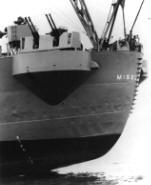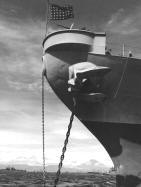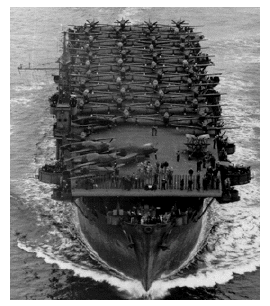|
Toll free 800 - 845-1140 |
|
Shipping
will be added to all orders, we always endeavor to give you the
best rate >>> Click for Rates. |
If you have any
questions or need help email us, call us or click here for HELP

Bogue Class Carrier Models
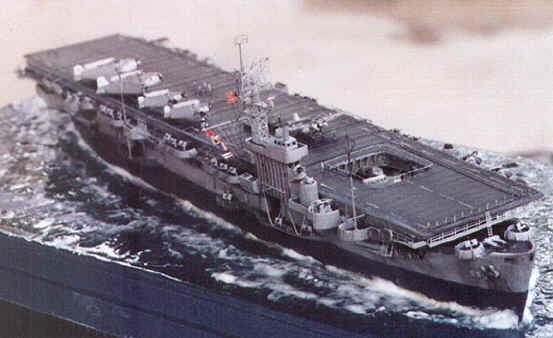
Bogue Class Carrier in 1/700 scale
built with GMM parts extra.
With new decals Any of the ships of this class listed below can be built
from this kit!
Built by Paolo Pizzi from navismagazine.com
Kit# A122 - 32.95 about 10 to 11" long
The United States Navy
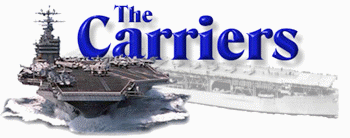 |
A Brief History
of U.S. Navy
Aircraft Carriers
The Escort Carriers |
Researched and written by
CE1 Robert A. Germinsky, U.S. Naval Reserve
All images below are hyperlinked to larger
images for better viewing. All images are official Navy photographs.
The Navy's escort carriers, called
"Jeep carriers" or (by the press) "baby flat tops," never received the
headlines or glory accorded their bigger sisters. Jeeps did the routine patrol work,
scouting and escorting of convoys that their larger fleet-type counterparts couldn't do.
Lightly armored, slower than the fleet carriers and with far less defensive armament and
aircraft, they performed admirably when called upon.
Jeep
carrier crews, who joked that "CVE" (the Navy's designation for this type of
ship) really stood for "Combustible, Vulnerable and Expendable," became experts
at hunting, finding and killing U-boats in both ocean theaters. Jeeps and their crews also
provided fighter and close air support for amphibious landings, and served as aircraft
transports as the tempo of the carrier war in the Pacific mounted to a crescendo.
The need for escort carriers came early in the war when German
submarines and aircraft were taking a devastating toll on convoy shipping. The heaviest
losses occurred far at sea where land-based aircraft couldn't operate. The Royal Navy had
experimented with catapult-launched fighter planes from merchantmen; while this was
somewhat successful in combating the U-boats, the number of planes that could be embarked
was limited. Something else was needed, and in a hurry. Great Britain appealed to the
United States for help.
No real specifications had been developed for escort carriers at
this time, although the Navy had looked into converting merchant ships for this purpose
before the war began. Thus, the quick solution was to build the early CVEs on merchant
ship hulls.
The first CVE was USS Long Island (CVE 1), converted from
a Maritime Commission freighter. Due to a shortage of merchant ship hulls, four escort
carriers were built on Cimarron-class fleet oiler hulls. These four, USS
Sangamon (CVE 26), USS Suwanee (CVE 27), USS Chenanago (CVE 28), and USS
Santee (CVE 29), were so successful in anti-submarine work and in covering amphibious
operations that, after participating in the landings in North Africa, they were deployed
to the Pacific. There, the fleet was in desperate need of carriers.
These early ships paved the way for a tremendous building program
of Jeeps in the United States. Between June 1941 and April 1945, 78 escort carriers would
be built and launched
a remarkable feat of wartime naval construction.
In the Atlantic, escort carriers originally stayed close to the
convoys they were protecting. Over time, tactics evolved that enabled the Jeep carriers
and their destroyer escorts to become independent "hunter-killer" groups. They
could attack concentrations of U-boats at will and were no longer required to provide
constant umbrella coverage for a convoy. This tactic was further refined by having the
escort carrier groups concentrate their efforts in areas where U-boats met their supply
submarines ("milch cows").
This operational phase was so successful that three Jeeps — USS
Core (CVE 13), USS Card (CVE 11) and USS Bogue (CVE 9) [left] — and
their escorting destroyers sank a total of 16 U-boats and 8 milch cows in a period of 98
days. During this time, U-boats sank only one merchantman and shot down only three planes
from the escort carriers. This loss of submarines, particularly the milch cows, was
a severe blow to the German Navy. With diminished capability for refueling U-boats at sea,
and with no friendly bases in the area, Admiral Karl Doenitz, commander of the German
U-boat fleet, was forced to withdraw his remaining supply submarines and cancel all U-boat
operations in the central Atlantic.
Testimony indeed to the hard work, skill and dedication of the
Jeeps and the men who served in them.
In the Pacific, Jeeps performed less glamorous but no less
important duties. Whether providing air cover for amphibious landings, ferrying planes,
resupplying the big carriers or performing tactical air strikes in support of ground
forces ashore, the little flat tops did whatever work had to be done. With all of their
versatility, however, they were never designed to go toe-to-toe with heavy enemy surface
units in a running sea battle. They never had to — until Oct. 25, 1944, off the
island of Samar in the Philippines.
Task Group 77.4 consisted of 16 CVEs organized into three task
units: Taffy 1, Taffy 2 and Taffy 3, so named because of their voice radio call signs.
These Jeeps were tasked with protecting the transports unloading in Leyte Gulf and
supporting troops ashore by striking enemy fortifications and airfields.
The little escort carriers were preparing for another day when,
early in the morning of Oct. 25, lookouts on board ships of Taffy 3 spotted Admiral Takeo
Kurita's heavy surface force attempting to enter Leyte Gulf and attack the transports and
beachhead. What Taffy 3 faced were four battleships and six heavy cruisers. Outgunned and
outmanned, the Jeeps and their accompanying destroyers and destroyer escorts did the only
thing they could in the face of such overwhelming odds and firepower — they attacked.
Taffy 3, which would bear the brunt of the fighting, began
launching aircraft and making smoke. Taffy 2 and Taffy 1, further away, began launching
their aircraft to come to the aid of Taffy 3. No heavy American surface units or carriers
were in the area; the Jeeps were on their own.
Aircraft from the Jeeps attacked and harassed the enemy, bombing
and strafing. Pilots then made "dry" runs on the cruisers and battleships when
they ran out of ammunition, in the hope of distracting the enemy gunners from shooting at
the little carriers. The gutsy little destroyers, completely overmatched, bore in and
carried out torpedo attacks, and fired at the massive battlewagons and cruisers with their
relatively puny 5-inch battery guns. The escort carriers themselves were saved from utter
destruction because of excellent maneuvering by their captains, and because, when hit,
their thin armor permitted the Japanese shells to pass completely through without
exploding.
Bold tactics on the part of the carriers, their planes and
destroyers convinced Kurita that he had encountered a much larger force of heavy American
surface ships and carriers. He had no idea that relatively little stood between his ships
and the transports now unloading in Leyte Gulf.
With little knowledge of the situation, and with his ships widely
dispersed after fending off the destroyer attacks, Kurita ordered his ships to break off
the action and retire from the area. The fight, however, was still not over.
Following Kurita's withdrawal, ships of Taffy 2 and Taffy 3 came
under attack from kamikazes, or Japanese suicide pilots. The kamikazes inflicted far
greater damage on the little carriers than did Kurita's gunfire, which only managed to
account for one carrier, USS Gambier Bay (CVE 73). Hits were scored on Santee,
Suwanee, USS Kitkun Bay (CVE 71) and USS St. Lo (CVE 63). Of these
four, St. Lo (left) was hit hardest, and she sank as a result.
This Battle off Samar, which lasted a little over two hours,
wrote a glorious chapter in the history of the Jeep carriers. By the time Kurita broke off
his attack and the kamikazes had been repulsed, more than 1,100 U.S. sailors were dead or
missing. Two escort carriers were lost along with four of the gallant little destroyers.
With no support from heavy American surface units or carriers, the Jeeps of Taffy 1, 2 and
3, their air crews and destroyers bravely and successfully defended the landing beaches
and transports at Leyte Gulf.
Sources:
Falk, Stanley L. Decision at Leyte. New York: W.W. Norton &
Company, Inc., 1966.
Morison, Samuel Eliot. History of United States Naval Operations in World War II. Vol.
10. The Atlantic Battle Won. Boston: Little, Brown and Company, 1956.
Morison. Vol. 12. Leyte, 1958.
Bogue Class:
- Displacement: 15,200 tons (full load)
- Length: 495'8"
- Beam: 69' at water line
- Draft: 26'
- Speed: 17 knots
- Armament 2 5"/38 DP, 10x2 40mm, 27 20mm, 28 planes
- Complement: 890-1205
- Geared turbines, 1 screw, 8,500 h.p.
- Max cruising radius: 22,500 miles @ 17 knots; 26,300 @ 15
knots
- Seattle-Tacoma built C3-S-A1 type hulls
| No. |
Name
|
Comm. |
Notes (: Lost)
|
| CVE-18 |
Altamaha |
15 Sep 42 |
|
| CVE-20 |
Barnes |
20 Feb 43 |
|
| CVE-21 |
Block Island |
8 Mar 43 |
29 May 44; torpedo in N. Atlantic |
| CVE-9 |
Bogue |
26 Sep 42 |
|
| CVE-23 |
Breton |
12 Apr 43 |
|
| CVE-11 |
Card |
8 Nov 42 |
|
| CVE-12 |
Copahee |
15 Jun 43 |
|
| CVE-13 |
Core |
10 Dec 42 |
|
| CVE-25 |
Croatan |
28 Apr 43 |
|
| CVE-16 |
Nassau |
20 Aug 42 |
|
| CVE-31 |
Prince William |
9 Apr 43 |
Prince William class -- CVE-32-54
transferred to UK |
Pictures for all these ships click here and go to Bogue Class
[_private/ashey2.htm]
